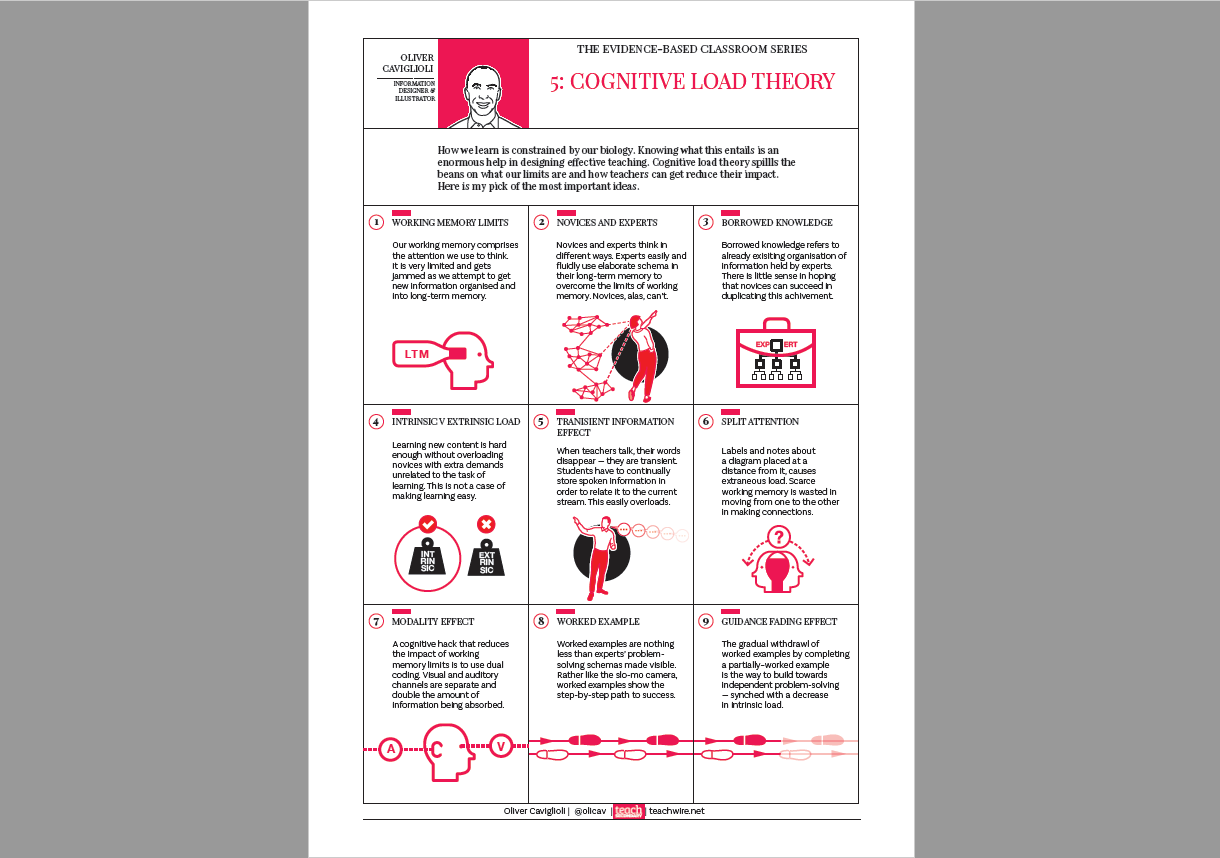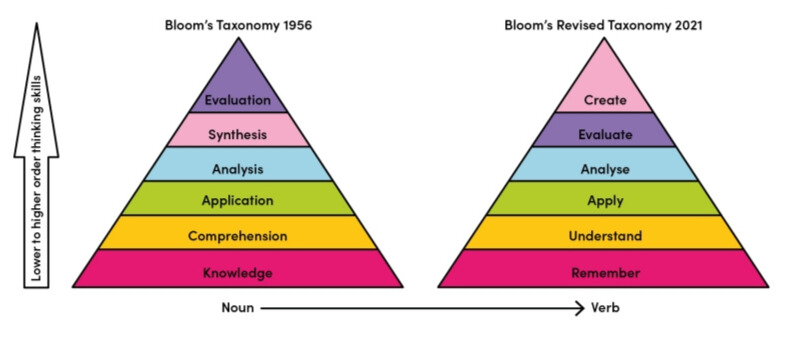Bloom’s Taxonomy – What it is and how to use it in school

Kit Betts-Masters unpacks the reasons why Bloom’s Taxonomy is a classic learning theory that can still spark innovation…

- by Kit Betts-Masters
- Science educator, physics specialist and content creator Visit website

What is Bloom’s Taxonomy?
When thinking about Bloom’s Taxonomy, start by asking your class which is the harder task – memorising a list of forces and their definitions, or coming up with a design for a paper glider?
Almost always, they’ll pick the memorisation task. Why? Because they conflate ‘time spent’ with ‘difficulty’.
It is, in fact, a much more demanding thing to design a paper glider. You have to get the dimensions right, choose the materials, consider the aerodynamics. As Leonardo da Vinci or the Wright brothers could tell you, it’s far from easy.
Kids need to be told that memorising things can take a long time, but that doing so is ultimately easy. It’s a process that works by simple repetition.
In contrast, the act of designing requires you to bring into being something which wasn’t there before. This is the central idea of Bloom’s Taxonomy and its application within education – that you can categorise different tasks according to their level of cognitive complexity.
The history of Bloom’s Taxonomy
Benjamin Bloom was someone with curriculum reform very much on his mind. In 1956, he led a group of educational psychologists. They published their ideas in a framework they called the ‘Taxonomy of Educational Objectives’.
It was an attempt at classifying educational goals, in a similar way to how organisms are classified in biological science.
The original text covered six major classes:
- knowledge
- comprehension
- application
- analysis
- synthesis
- evaluation
These were ordered from simple to complex respectively – though not necessarily presented in order of cognitive difficulty.
Even then, Bloom already knew there would be issues with perceiving these educational goals as a strict hierarchy.
Bloom’s Revised Taxonomy
45 years later we then saw the emergence of the ‘Revised Taxonomy’ – a modified form of the original classification system more directly applicable to the education system.
It’s here that we see verbs such as ‘describe’, ‘explain’, ‘compare’ and ‘justify’ being linked to levels in the cognitive pyramid, which continue to act as command words in our assessments to this day.
Synthesis versus creation

This revised version (above) was set out in the 2001 book A Taxonomy for Learning, Teaching and Assessing by Lorin Anderson and David Krathwoh, though beware – you’ll be entering a rabbit hole that goes very deep indeed.
As a creative teacher and something of a deep thinker, I’ve always been interested in the relative positions of the top two levels in the original Bloom’s taxonomy compared to the revised version.
The latter notably places the act of creativity higher than the process of evaluation. Moreover, the original taxonomy’s ‘synthesis’ is replaced with the similar, but really quite different ‘create’.
Bringing two things together to make something new is arguably not quite as demanding as bringing something truly innovative into being.
It’s also worth noting that ‘remember’ replaces ‘knowledge’ – which gives us a useful insight into how some of the key drivers of current discourse around what constitutes good teaching and learning in classrooms may have first risen to prominence.
Is Bloom’s Taxonomy still relevant?
Bloom’s Taxonomy still has a place in our teaching, even amid the current vogue for cognitive load theory. It’s helpful for students to know that practising the quick and accurate recall of facts will gift them increased ‘brain space’ with which to tackle more difficult challenges.
Trending
Rapid recall can, for example, reduce the cognitive load of exam questions that involve evaluation or determination.
“Bloom’s Taxonomy still has a place in our teaching, even amid the current vogue for cognitive load theory”
The integration of spaced, interleaved retrieval practice in the classroom is largely based on a 2013 meta study by Dunlosky et al.
Yet while this practice caters well for the bottom two tiers of Bloom’s Taxonomy, there’s still a need for further innovation around developing higher-order teaching strategies.
Happily, however, Dunlosky et al points the way there too. Their study highlights two potentially effective solutions – Elaborative Interrogation (a method of explaining why we know a thing to be true), and Self Explanation (a method of explaining to oneself the cognitive route we took to solving a problem).
How I use Bloom’s Taxonomy in the classroom
Bloom’s Taxonomy has been the single most influential theory of my classroom career. I’ve used it to adapt activities and questions in my lessons to the objectives of each group.
It’s enabled my students to better discern between one lesson element and another, and it’s helped them feel more comfortable with tackling those bits of the curriculum they find more challenging. Some questions are meant to be harder! They’re designed that way!
“Bloom’s Taxonomy has been the single most influential theory of my classroom career”
The more opportunities students have to work at this higher level, the quicker they can switch into actively and regularly working at this level.
That’s incredibly important, given that within even the same exam question, students may have to constantly shift between describing, explaining, applying, evaluating and suggesting.
A hallmark of excellence
An application of Bloom’s Taxonomy has underpinned virtually all of what I do in schools. It’s a subtle hallmark of an excellent lesson, but conspicuous by its absence to trained observers.
As a leader, I’ll always include a Bloom’s Taxonomy scale of challenge in any lesson objectives I give candidates at interview.
When planning, I’ll always try to think at the evaluative and creative level of the taxonomy. In meetings, I’ll try to make myself more useful by working at the highest level of the taxonomy. And in my writing, I’m always trying to give the reader my high-level thinking, as that’s the most valuable stuff.
An understanding of Bloom’s Taxonomy is a high-utility form of knowledge, whatever stage of the teaching journey you’re at.
“Look at your lessons through the lens of Bloom’s Taxonomy”
If you’re a trainee just starting out, and feeling overwhelmed by the barrage of well-meant advice you’re receiving, let me assure you this is one of the most important pieces of advice you’ll hear.
Perhaps you’re in a TLR post, busily quality-assuring a set of resources. Look at your lessons through the lens of Bloom’s Taxonomy – rest assured, your students will thank you for their eventual grades if you do.
Or you might be a senior leader, planning out a new term of CPD and learning across your school or trust. Make Bloom’s Taxonomy a priority, and make it clear to your staff how fundamental a concept it is in teaching, learning and assessment.
Five more ways to use Bloom’s Taxonomy in school
- Match command words to assessment objectives, and notice how they fit within Bloom’s Taxonomy structure. Then explicitly teach Bloom’s Taxonomy in relation to assessments.
- Use mark schemes to analyse which Bloom’s level each mark is assessing. Use this to help students match their test performance against assessment objectives in a spreadsheet.
- Structure lesson questions using command words from the exam board, in ascending order of Bloom’s Taxonomy levels.
- Analyse lesson elements as you plan, then consider if the balance of Bloom’s levels is right for your class and content. Allow more independent learners to learn facts on their own for homework, and reserve their classroom time for the practice of higher order skills.
- Collaborate on paired observations focused on Bloom’s Taxonomy. Analyse how much time each class spends working at each Bloom’s level, then check whether this was appropriate for the target level of the group.
Kit Betts-Masters is a lead practitioner for science and a former head of physics and science. He is also the author of several physics education books, and produces physics, education and technology videos for YouTube. For more information, visit evaluateeverything.co.uk










